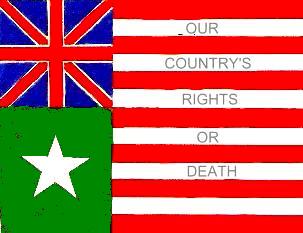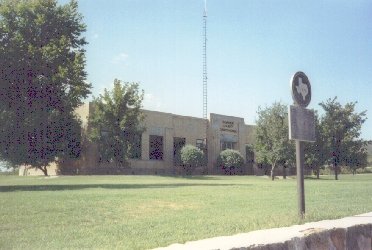
Picture of Gail Borden, Jr.

Excerpted from Noah Smithwick, The Evolution of a State, or Recollections of Old Texas Days, Austin, 1900, Chapter XXIV
Here, too, came Gail Borden, of condensed milk fame, whom I had known in old San Felipe de Austin away back in the '20s, when he was only a blacksmith. I had lost sight of him for years, when he drove up to my door at the Mormon mills, he in the meantime having been to Europe in the interest of condensed milk. He had also taken up the homeopathic remedies, and prefixed a Dr. to his name. His business in Burnet county, however, had no connection with his inventions or his practice. He had land located on Sandy creek, and there had been some particles of gold found in the sand, which created considerable excitement, which Dr. Borden was curious to investigate. The gold mines didn't "pan out." There was an old silver mine in the vicinity, which had been worked by the Spaniards, but it had apparently "petered out."
Dr. Borden imparted to me the great secret of his school of medicine as he understood it. Said he: "It is no use to be a doctor unless you put on the airs of one. Nine times out of ten sickness is caused by overeating or eating unwholesome food, but a patient gets angry if you tell him so; you must humor him. This I do by talking one grain of calomel and dividing it into infinitesimal parts, adding sufficient starch to each part to make one of these little pellets (exhibiting a little vial of tiny white pills), then glaze them over with sugar. In prescribing for a patient I caution him about his diet, warning him that the pills have calomel in them. Well, the result is that he abstains from hurtful articles of food, which is all he needs to do anyway. But I have strong medicine to use in cases of need." It struck me that there was a good deal of truth in his argument. After spending a few days with us Gail Borden, too, went his way and was lost to view. Another old time friend, one of the original three hundred, I found settled in Burnet county, Captain Jesse Burnham, with whom I had sojourned at his home near the site of the present city of LaGrange in the summer of 1827. He, too, had been "crowded" and consequently sold out and moved to Burnet, where he engaged in the sheep business, one of the first men in the country to try the experiment.

Gail Borden was a member of an 1833 Texas delegation to Mexico that advocated defending their rights by force of arms if Mexico did not right their grievances.
He also founded the Telegraph and Texas Land Register, the first newspaper in Texas, which he later sold.
 AUSTIN COLONY, TX
AUSTIN COLONY, TX
Austin's Colony was an Anglo-American settlement established in Texas by Stephen F. Austin in 1821-23. The project was first launched while Texas was still part of Spain by Austin's father, Moses Austin, who died in 1821. The initial plan, which was ultimately authorized by the Mexican national government, called for the introduction of 300 American families into Texas. Stephen F. Austin made four subsequent colonization contracts with the state of Coahuila and Texas between 1825 and 1831. By the time the colonial land offices were closed in 1835, almost 1000 land titles had been issued under all of Austin's contracts.
Land Distribution in Austin's Colony involved several individual[s]: the empresario (Austin), a commissioner appointed by the government, a title clerk, and the surveyors. Representing the government, the commissioner was responsible for administering and recording the land titles and organizing the archives of the colony. In July 1823, Governor Luciano Garcia appointed Felipe Enrique Neri, the Baron de Bastrop, as the first commissioner for Austin's Colony. Subsequent commissioners were Gaspar Flores, Miguel Arciniega, Stephen F. Austin (acting as his own commissioner), and Robert Peebles. Samuel May Williams was hired by Austin in 1823, and performed a prodigious amount of work as secretary, title clerk and agent for Austin, and ultimately was his partner in the final colony contract. By 1834, the duties of land office clerk were increasingly performed by Gail Borden, Jr. Among the surveyors were Rawson Alley, Gail Borden, Jr., John P. Borden, Thomas H. Borden, Samuel P. Browne, Horatio Chriesman, John Cooke, Samuel Dickson, Jesse U. Evans, Isaac Hughes, Seth Ingram, John Jiams, Francis W. Johnson, James Kerr, George W. Patrick, John Goodloe Warren Pierson, William Selkirk, Bartlett Sims, H. Smith, and Elias R. Wightman.
The first Texas Land Commissioner, John P. Borden, obtained the Austin Colony records in 1837 as part of his orders to acquire all records pertaining to land grants in the possession of empresarios and other authorities. The earliest known inventory of the records of Austin's Colony was prepared November 14, 1835 by Asa Mitchell, Robert Peebles, and C.C. Dyer, acting as commissioners for the Consultation when the Mexican land offices were closed. The general descriptions in that list agree with the present inventory of the Austin Colony Records.
 Baker's Flag of San Felipe. According to the Telegraph and Texas
Register, San Felipe, 5 Mar 1836 "....the English Jack showing the
origin of Anglo-Americans, thirteen stripes representing that most of
the colonists in Texas are from the United States; the Star is Texas,
the only state in Mexico retaining the least spark of the light of
Liberty; tricolor is Mexican, showing that we onced belonged to the
confederacy; the whole flag is historic." It was dubbed the San Felipe
flag and based on ideas expressed to Gail Borden Jr. by Stephen F. Austin
in the enclosure to a letter from New Orleans of 18 Jan 1836: "I shall
preach independence all over the US wherever I go--What do you
think of the inclosed idea of a flag." The flag was presented to the
company of volunteers commanded by Captain Moseley Baker (John P.
Borden, 1st. Lt.) by Gail Borden Jr. in the name of "two ladies" from the
area as they marched from San Felipe 29 Feb 1836 for Gonzales. Capt. Baker made a speech to his company in response to
the presentation referring to the flag "this banner of independence." He said "first in your hands is placed the Texas flag;
let you be the last to see it strike to the invading foe! Let no other feeling ever glow in your bosom than that expressed
in the motto on your banner, 'Our Country's Rights or Death.'.....Let us all raise our hands to heaven and swear, 'The
Texas flag shall wave triumphant or we will sleep in death!'" It was claimed to have been flown at San Jacinto by those in
Sherman's division. (Modified from Gilbert, Flags of Texas).
Baker's Flag of San Felipe. According to the Telegraph and Texas
Register, San Felipe, 5 Mar 1836 "....the English Jack showing the
origin of Anglo-Americans, thirteen stripes representing that most of
the colonists in Texas are from the United States; the Star is Texas,
the only state in Mexico retaining the least spark of the light of
Liberty; tricolor is Mexican, showing that we onced belonged to the
confederacy; the whole flag is historic." It was dubbed the San Felipe
flag and based on ideas expressed to Gail Borden Jr. by Stephen F. Austin
in the enclosure to a letter from New Orleans of 18 Jan 1836: "I shall
preach independence all over the US wherever I go--What do you
think of the inclosed idea of a flag." The flag was presented to the
company of volunteers commanded by Captain Moseley Baker (John P.
Borden, 1st. Lt.) by Gail Borden Jr. in the name of "two ladies" from the
area as they marched from San Felipe 29 Feb 1836 for Gonzales. Capt. Baker made a speech to his company in response to
the presentation referring to the flag "this banner of independence." He said "first in your hands is placed the Texas flag;
let you be the last to see it strike to the invading foe! Let no other feeling ever glow in your bosom than that expressed
in the motto on your banner, 'Our Country's Rights or Death.'.....Let us all raise our hands to heaven and swear, 'The
Texas flag shall wave triumphant or we will sleep in death!'" It was claimed to have been flown at San Jacinto by those in
Sherman's division. (Modified from Gilbert, Flags of Texas).
In 1836, the founders of Houston (Augustus C. and John K. Allen) call on Gail Borden (publisher, surveyor, and originator of condensed milk) and Thomas H. Borden (Gail's brother) to survey and map the site. Gail Borden laid out the town's streets 80' wide, with the principal east-west thoroughfare (Texas Avenue) 100' wide.

1857 - Gail Borden Builds Condensery at Burrville CT
In 1863 Gail Borden erected a factory in Brewster for the daily processing and canning of 80,000 quarts of milk produced by local cows on Putnam's 20,000 acres of farmland.
The story starts...
"Gail Borden was not a woman despite the spelling of his first name. He never lived in Elgin, and he never donated funds for the
library which bears his name. How his name became attached to our library is as fascinating and complex as the man himself. "

Old (1894 picture of library)
Complete story
Gail Borden, Jr., founder of Borden Milk Co.

Scheib, Winifred H. (March/April 1997) 'Gail Borden, An American Original', Silver Magazine
Frantz, J.B. (1948) 'Gail Borden as a businessman', Bulletin of the Business Historical Society
Frantz, J.B. (1959) 'Borden at the century mark: case study of a centennial observance', Business History Review
Frantz, Joe B., and Choate, Julian Ernest, Jr.: Gail Borden: Dairyman to a Nation
1955
Wade, Mary Dodson :Milk, Meat Biscuits and the Terraqueous Machine 1987 (1988)
Pardis, A.: Gail Borden 1964
RETURN